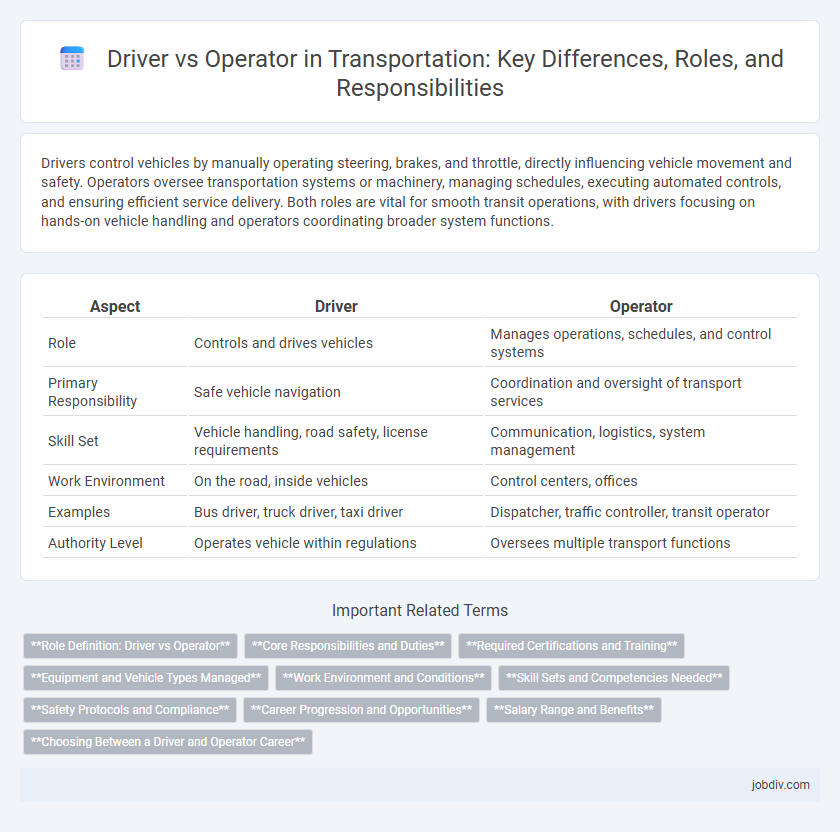Drivers control vehicles by manually operating steering, brakes, and throttle, directly influencing vehicle movement and safety. Operators oversee transportation systems or machinery, managing schedules, executing automated controls, and ensuring efficient service delivery. Both roles are vital for smooth transit operations, with drivers focusing on hands-on vehicle handling and operators coordinating broader system functions.
Table of Comparison
| Aspect | Driver | Operator |
|---|---|---|
| Role | Controls and drives vehicles | Manages operations, schedules, and control systems |
| Primary Responsibility | Safe vehicle navigation | Coordination and oversight of transport services |
| Skill Set | Vehicle handling, road safety, license requirements | Communication, logistics, system management |
| Work Environment | On the road, inside vehicles | Control centers, offices |
| Examples | Bus driver, truck driver, taxi driver | Dispatcher, traffic controller, transit operator |
| Authority Level | Operates vehicle within regulations | Oversees multiple transport functions |
Role Definition: Driver vs Operator
A driver primarily controls and maneuvers vehicles, ensuring safe and efficient transportation of passengers or goods. An operator oversees the functioning of transportation systems or machinery, often managing schedules, equipment performance, and operational protocols. While drivers focus on hands-on vehicle operation, operators concentrate on broader system coordination and management responsibilities.
Core Responsibilities and Duties
Drivers are responsible for operating vehicles safely, following traffic laws, and ensuring timely passenger or cargo transport. Operators oversee the broader management of transportation systems, including scheduling, vehicle maintenance, and coordinating logistics. Both roles require strong adherence to safety protocols, but operators typically handle administrative and operational planning tasks beyond direct vehicle control.
Required Certifications and Training
Drivers must obtain a commercial driver's license (CDL) and complete specialized training programs tailored to vehicle types and safety regulations. Operators require certification in operating specific machinery or equipment, often including OSHA compliance and safety protocol training. Both roles demand continuous education to maintain certifications and adhere to evolving transportation industry standards.
Equipment and Vehicle Types Managed
Drivers specialize in operating specific vehicles such as trucks, buses, or cars, focusing on safe navigation and compliance with traffic regulations. Operators manage a broader range of equipment, including heavy machinery like cranes, forklifts, and construction vehicles, requiring technical expertise in maneuvering complex machinery. Vehicle types managed by drivers emphasize road transportation, while operators handle diverse equipment across construction, logistics, and industrial sectors.
Work Environment and Conditions
Drivers typically work in dynamic environments involving constant interaction with traffic, weather conditions, and passenger safety protocols, requiring strong situational awareness and adaptability. Operators often perform tasks in more controlled settings such as control rooms or maintenance facilities, focusing on equipment monitoring, system management, and operational coordination under regulated schedules. Both roles demand adherence to safety standards but differ significantly in physical demands and work situational factors.
Skill Sets and Competencies Needed
Drivers require strong vehicle handling skills, situational awareness, and adherence to traffic laws to ensure safe and efficient transportation. Operators need advanced technical knowledge, proficiency in equipment control systems, and problem-solving abilities to manage complex machinery and oversee operational workflows. Both roles demand excellent communication, decision-making skills, and the ability to respond promptly to dynamic conditions in transportation environments.
Safety Protocols and Compliance
Drivers are responsible for adhering to road safety regulations, vehicle inspections, and proper use of safety equipment to minimize accidents and injuries. Operators implement and enforce safety protocols across transportation systems, ensuring compliance with regulatory standards such as OSHA and DOT guidelines. Both roles require rigorous training on emergency procedures, hazard identification, and continuous monitoring to maintain workplace safety and regulatory compliance.
Career Progression and Opportunities
Drivers often begin their careers with entry-level positions that provide foundational experience in vehicle operation and safety protocols, while operators typically advance into specialized roles managing complex machinery or overseeing system functions. Career progression for drivers can lead to opportunities such as fleet management, logistics coordination, or instructor positions, leveraging hands-on driving experience. Operators may transition into supervisory or technical roles in transportation infrastructure, enhancing expertise in system operations and maintenance for broader career growth.
Salary Range and Benefits
Driver salaries generally range from $30,000 to $50,000 annually, often including basic benefits such as health insurance and paid time off. Operators typically earn between $40,000 and $65,000 per year, with more comprehensive benefits packages that may include retirement plans, performance bonuses, and advanced training opportunities. Variations in salary and benefits depend on industry, location, and level of responsibility within transportation roles.
Choosing Between a Driver and Operator Career
Choosing between a driver and operator career depends on skill preferences, work environment, and job responsibilities; drivers primarily focus on vehicle control and road navigation, while operators manage machinery or equipment in various industries such as construction or logistics. Salary ranges vary, with commercial drivers earning an average of $45,000 to $60,000 annually, whereas heavy equipment operators can earn between $50,000 and $70,000, influenced by location and experience. Career growth opportunities exist in both paths, but operators may advance into specialized technical roles, while drivers can pursue commercial driving endorsements or logistics management.
Driver vs Operator Infographic

 jobdiv.com
jobdiv.com